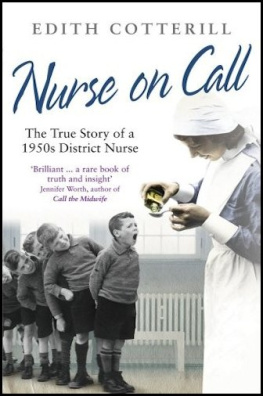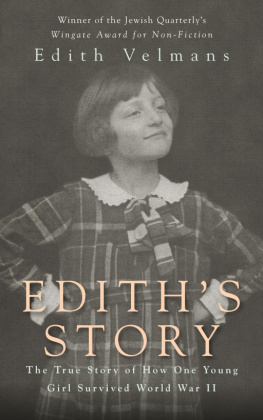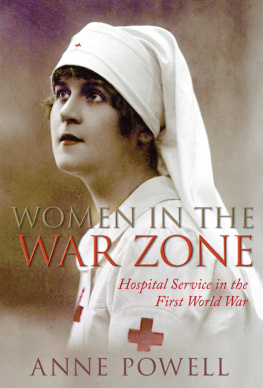Contents
Page List
Guide

EDITH
BLAKES
WAR
K RISTA V ANE -T EMPEST is the daughter of a teacher and was raised in country New South Wales. She studied law, English, history and politics at the Australian National University then worked as a lawyer before starting to write. In her spare time, she is a volunteer guide at the Australian War Memorial. She lives in Canberra with her husband and three children.
Beautifully written and an engaging read, Edith Blakes War opens a window on unsung areas of Australian nurses service at war. Krista Vane-Tempests meticulous research enhances understanding but never intrudes, as Sister Blakes own voice brings her wartime experiences vibrantly to life. An ultimately moving book born of connection to family across generations.
JANET BUTLER
Edith Blakes story powerfully evokes the horrors and dangers of nursing during the Great War while capturing the poignant and special bond Australian nurses forged with Anzac soldiers. Krista Vane-Tempest deftly weaves the larger context of the war throughout Edies remarkable letters home and gives her the long overdue recognition her courage warrants.
PETER REES
More than a biography, Krista Vane-Tempest has penned a tribute to the contribution and sacrifice of Australian women during the First World War. In doing so, she has rediscovered the evocative story of Edith Blake, nurse to the Anzacs and British troops and whose life was tragically lost in that terrible conflict.
KARL JAMES
A NewSouth book
Published by
NewSouth Publishing
University of New South Wales Press Ltd
University of New South Wales
Sydney NSW 2052
AUSTRALIA
newsouthpublishing.com
Krista Vane-Tempest 2021
First published 2021
10 9 8 7 6 5 4 3 2 1
This book is copyright. Apart from any fair dealing for the purpose of private study, research, criticism or review, as permitted under the Copyright Act, no part of this book may be reproduced by any process without written permission. Inquiries should be addressed to the publisher.
 | A catalogue record for this
book is available from the
National Library of Australia |
| ISBN: | 9781742237398 (paperback) |
| 9781742249964 (ebook) |
| 9781742249933 (ePDF) |
Design Josephine Pajor-Markus
Cover design Nada Backovic
Cover images (top) Studio portrait of Sister Edith Blake, Queen Alexandras Imperial Military Nursing Service Reserve, AWM P11193.004; (bottom right) Glenart Castle, AWM PS1195; (bottom left) Sister Edith Blake at 17th British General Hospital, AWM P11193.006.
Printer Griffin Press, part of Ovato
All reasonable efforts were taken to obtain permission to use copyright material reproduced in this book, but in some cases copyright could not be traced. The author welcomes information in this regard.
This book is printed on paper using fibre supplied from plantation or sustainably managed forests.

CONTENTS
LIST OF ABBREVIATIONS
| AAH | Australian Auxiliary Hospital |
| AAMC | Australian Army Medical Corps |
| AANS | Australian Army Nursing Service |
| ACCS | Australian Casualty Clearing Station |
| AGH | Australian General Hospital |
| AIF | Australian Imperial Force |
| ATNA | Australasian Trained Nurses Association |
| BGH | British General Hospital |
| CCS | casualty clearing stations |
| HMAS | His Majestys Australian Ship |
| HMAT | His Majestys Australian Transport |
| HMHS | His Majestys Hospital Ship |
| HMS | His Majestys Ship |
| OC | Officer Commanding |
| MO | Medical officer |
| POW | prisoner of war |
| QAIMNS | Queen Alexandras Imperial Military Nursing Service |
| QAIMNSR | Queen Alexandras Imperial Military Nursing Service Reserve |
| RAMC | Royal Army Medical Corps |
| RFC | Royal Flying Corps |
| RMS | Royal Mail Ship |
| RNAS | Royal Naval Air Service |
| SMS | Seiner Majestt Schiff (His Majestys Ship) |
| SS | Steam Ship |
| USS | United States Ship |
| VAD | Voluntary Aid Detachment |
PROLOGUE
In the early hours of 26 February 1918, His Majestys Hospital Ship (HMHS) Glenart Castle steamed into the Bristol Channel, heading for France to pick up wounded men from the killing fields of the Western Front. On board was a thirty-two-year-old Australian nurse, Edith Blake.
As HMHS Glenart Castle cut through choppy waters whipped up by a cold wind, crews on passing fishing boats observed her lights blazing from bow to stern, her white hull clearly displaying the broad green band and red crosses that identified her as a hospital ship.
Unbeknown to the ships company, a German U-boat lurked in the waters below. The submarine, UC-56, stalked Glenart Castle in silence for over an hour, her torpedoes at the ready.
Shortly before 4 am the crew of the Glenart Castle was changing shift when an almighty explosion ripped the ships hull open like a tin can and smashed her starboard decks. Men in the starboard engine room were killed immediately; others were thrown across the decks or tossed from their bunks as the ship lurched violently. HMHS Glenart Castle shuddered to a halt and was cast into darkness.
Although Germany had promised to respect the safe passage of hospital ships in those waters, UC-56 had taken deadly aim and fired.
Survivors told a Naval Court of Enquiry what happened next. Men ran to their lifeboat stations and began to lower the boats in response to six piercing shrieks from the steam whistle. Water gushed into the ragged hole and the ship listed starboard. In the darkness below, people groped for the doors and stairways that would deliver them to the boat decks. Then the call EVERY MAN FOR HIMSELF! went up.
Waves dashed lifeboats against the broken hull. As the ship rolled further starboard, men worked desperately to launch the portside boats. Some of these made it to the heaving surface and were set free. Others dangled from the davits (cranes that swing out to launch lifeboats) as the ship groaned and her bow strained towards the dark sky, tipping the boats screaming occupants into the sea. When the ship plunged down sternwards, some boats were swamped by the wall of wash. People still clinging to the ship jumped for their lives and were sucked under.
It took just seven or eight minutes for the Glenart Castle to sink. Of more than 180 crew and medical personnel on board, only twenty-nine men survived. In the subsequent official enquiry, no-one could say what had happened to the eight nurses whose mission was to save lives.
So it was that Edith Blakes war came to an end in the black waters of the Bristol Channel. To the best of our knowledge she was the only Australian nurse killed in action in the First World War.











